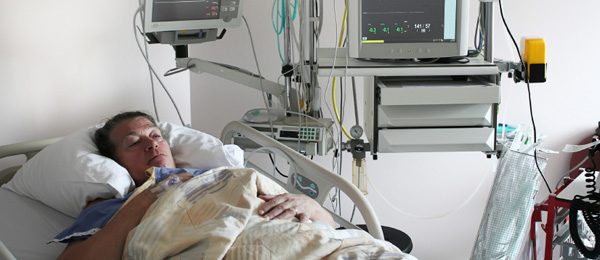
New network of experts formed to fight sepsis
A new alliance of experts in emergency medicine, critical care medicine and infectious diseases have joined to push for increased awareness and earlier intervention to fight the unfolding threat of sepsis, a little-recognised condition that kills more people than prostate cancer and breast cancer combined.
Critical care researcher Professor Simon Finfer, of The George Institute and The University of Sydney, says the true rates of death are likely even higher than currently thought because many deaths due to sepsis are attributed to other underlying diseases.
“We know that at least one in eight people admitted to intensive care units in Australia are admitted because they have sepsis - this number has increased by over 70 per cent in the last 10 years.”
Sepsis is the life-threatening condition that arises when a patient’s response to an infection damages their tissues and organs.
Of the 30,000 Australians thought to contract sepsis each year, about a quarter of adults die without leaving hospital. The death rate for children is lower, at about 10 per cent.
“More people die of sepsis than from well-known diseases such as prostate cancer and breast cancer combined,” Professor Finfer says.
“We are still seeing too many deaths from sepsis and many people. Possibly most people outside the healthcare area have never heard of sepsis. Given that early treatment reduces the risk of death, raising public awareness will save lives.”
“My key point is that, if sepsis is recognised and treated early death can be prevented; each hour’s delay in the treatment of sepsis increases the risk of death by about eight per cent.
Clinical Excellence Commission CEO Professor Cliff Hughes says he is delighted that the Australian Sepsis Network is joining the fight against sepsis.
In an economic analysis, the CEC estimates that medical services to treat sepsis could cost NSW $3.7 billion over the next 10 years.
The CEC has implemented a program known as SEPSIS KILLS since 2011, which has already improved outcomes in 180 hospitals across NSW. There has been a significant decrease in the median time to commence treatment with intravenous antibiotics from 4 hours in 2011, to consistently less than 60 minutes in 2013 and 2014.
Dr Robert Herkes, Clinical Director of the Australian Commission on Safety and Quality in Health Care (the Commission), says “Sepsis is a major cause of death and disability in Australia so preventing the infections that cause sepsis is absolutely critical.”
The Commission has developed a number of initiatives aimed at reducing the prevalence of infections that occur in hospitals, including a National Safety and Quality Health Service Standard for Preventing and Controlling Healthcare Associated Infections, National Hand Hygiene Initiative and Antimicrobial Stewardship Program.
Sydney-based electrical supervisor Michael Sutton, whose wife Sharon died this year from sepsis, welcomed the move to boost efforts to fight sepsis.
“I tell the guys at work that she died of sepsis after leukaemia. They all know what leukaemia is. But they say: ‘What is sepsis? “I didn’t know either, and had nowhere to find out. It turns out that more than twice as many people a year die of sepsis than die of leukaemia.”
The Australian Sepsis Network is a new group of researchers, health groups and clinicians who work together to improve the outcome of patients with sepsis. They believe it is crucial to raise awareness of sepsis, the early warning signs, and how to prevent death, and today launched a new website.
Case study
Michael Sutton is an electrical supervisor left devastated by the death of his wife, Sharon, from sepsis in February 2014. She first visited a GP with symptoms attributed to gastroenteritis.
She did not recover, however, and was admitted to hospital. After several weeks she deteriorated to the point that she was moved to another hospital. At this point, Michael overheard two doctors wondering whether the problem was sepsis.
She was eventually diagnosed with, and treated for, leukaemia. Despite this, her condition deteriorated further and she died a short time later. To Michael’s surprise, biopsies determined that she died of sepsis. Doctors have suggested that the chemotherapy weakened her immune system to the point where she was unable to fight off sepsis.
Mike is left with questions. “When did she get sepsis? Why didn’t any of her doctors recognise it or, if they had suspicions, why didn’t they do anything about it? What else could have been done for her?”
He feels that if he had been told, he might have been able to prepare himself somehow for her death.
“I tell the guys at work that she died of sepsis after leukaemia. They all know what leukaemia is. But they say: ‘What is sepsis? “I didn’t know either, and had nowhere to find out. It turns out that more than twice as many people a year die of sepsis than leukaemia.
“But if you’re a survivor or your family member has died of sepsis, where do you go? What can you do? How do you find other people in your situation? The doctors and nurses are really good, but they’re not there to be welfare support.”
Mike has spent the months since his wife died trying to find answers. He’s spent countless hours on the internet, researching sepsis. He’s been in touch with foundations and experts in the US and Europe. On his son’s advice, he set up a Twitter account. On his first night he had three replies. By the next morning he had 3,000 followers.
Now, he is out to raise community sepsis awareness in Australia.
Q and A
What is Sepsis?
Sepsis is the life-threatening condition that arises when the body’s response to an infection damages its own tissues and organs. It can lead to shock, failure of multiple organs, and death. Organ failure and death are more likely if sepsis is not recognized early and not treated promptly.
How do people get it? Do you just catch it in hospitals?
Sepsis results from an infection which may arise in the lungs, urinary tract, skin, abdomen or other part of the body. The most common causes of sepsis are respiratory infections, abdominal infections (such as can arise from a perforated bowel or from kidney or gall stones) and urinary infections. Sepsis may occur in patients both in the community and those already being treated in hospital.
How widespread is it?
It affects at least 30,000 people in Australia each year and causes about 7,500 deaths, or around 20 deaths each day.
What are the signs?
Common symptoms of sepsis are fever, chills, rapid breathing and heart rate, rash, confusion and disorientation. Many of these symptoms, such as fever and difficulty breathing, mimic other conditions, making sepsis hard to diagnose in its early stages.
Should patients’ families be aware of the signs so they can alert the doctor or nurse? Do they have a role in prevention/getting patients to treatment immediately?
Anyone showing signs of sepsis should seek medical treatment immediately.
Do doctors know enough about sepsis? If not, what is being done about this?
All doctors and nurses are aware of sepsis but the diagnosis can be difficult. For that reason the NSW CEC launched a program to increase awareness of sepsis within hospitals and many individual doctors are working both to reduce the incidence of sepsis and to improve outcomes for those who contract it.
How do you prevent it?
The best way to prevent sepsis is to prevent the infection that causes it. All public hospitals and day procedure services in Australia are required to implement systems and processes to prevent and control healthcare associated infections as part of the National Safety and Quality Health Service Standards.
How do you treat it?
People with sepsis are treated in hospital and those with severe sepsis are usually treated in the intensive care unit. Treatment targets the infection, while supporting vital organs and giving intravenous fluids and drugs to maintain blood pressure. In severe cases when organs fail, life-support treatments such as artificial ventilation (breathing machine) or kidney dialysis, may be necessary. Surgery may be needed to control a local site of infection such as in appendicitis or following a perforated bowel.
Does everyone who gets it end up in an intensive care unit (ICU)?
No, although anyone with sepsis that does not improve rapidly or resolve quickly should be referred to an intensive care unit
If you survive, what damage does the body sustain?
Many people who survive severe sepsis recover completely and return to normal lives. Some people, especially those who have required prolonged treatment in an ICU may experience longer term problems including permanent organ damage. Other longer term effects include difficulty sleeping, concentrating or returning to work, reduced energy and musculoskeletal problems.
Is there an approximate cost to the healthcare system of sepsis?
The CEC has estimated that over the next 10 years sepsis-related condition will cost NSW $3.7 billion
What previous research has been carried out on sepsis? What did it find?
There has been a vast amount of research and billions of dollars spent but at present there is no drug treatment proven effective for sepsis. Treatment with steroids remains controversial and The George Institute is conducting the largest ever trial of that treatment. The research tells us that the best way to improve survival is either to prevent sepsis or to recognise it as early as possible and treat with antibiotics and fluids.
What gaps are there? What additional research needs to be carried out?
Gaps include whether steroids improve outcome and whether sepsis can be reliably recognised using simple diagnostic signs. Answering these questions would allow treatment to begin earlier, for example in the ambulance or immediately on arrival to hospital.






